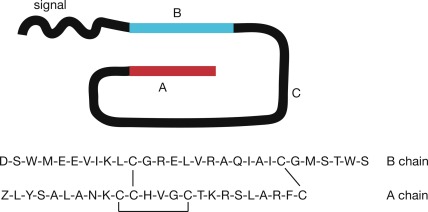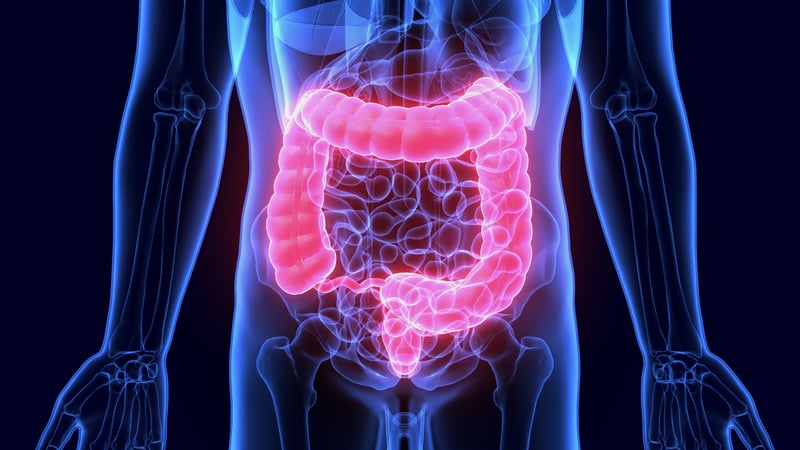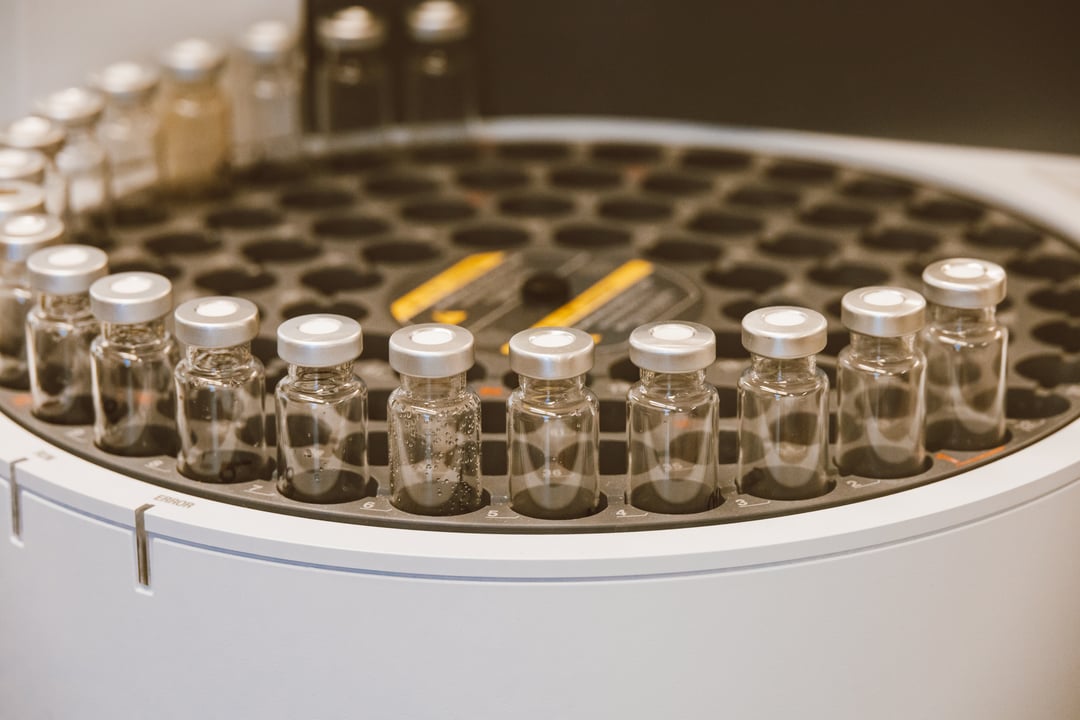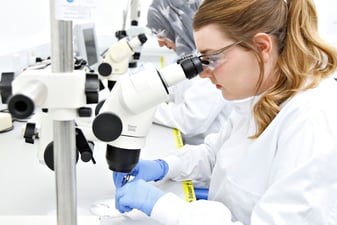The human relaxin peptide, also known as relaxin-2 (RLN2), is a 6kDa polypeptide hormone that is 48 amino acids in length.1,2 It was first discovered in 1926 by Frederick Hisawand and belongs to a wider collection of polypeptides called the relaxin peptide family.3,4 All seven family members are critical to drug development and play a clinically significant role in health and disease.4 In this article, we will explore the physiology and pharmacology of the human relaxin peptide family members.
Human relaxin peptide family members
The human relaxin peptides are broadly expressed in the body, functioning in reproductive, metabolic, cardiovascular, and neurological health.5 The functional selectivity varies greatly between family members, resulting in distinct interactions between these peptides and their native receptors.4
Most members interact with the relaxin family peptide receptors (RXFP), a type of G-coupled protein receptor (GCPR) found in several locations within the body.4 RLN2, insulin-like peptide (INSL) 3, relaxin-3 (RLN3), and INL5, interact with RXFP1, 2, 3, and 4 respectively.4 All members of the relaxin peptide family bind to their cognate receptors via distinct residues present in their α- and β-chains.4
| Peptide–Receptor pair | Physiological role | Clinical significance |
|---|---|---|
| RLN1 | Unknown | Unknown |
| RLN2-RXFP1 | Pregnancy roles | Heart disease |
| 1. Remodelling of the uterus throughout pregnancy | ||
| 2. Development of mammary nipple | Fibrosis | |
| Cardiovascular adaptations | ||
| INSL3-RXFP2 | 1. Growth and development of the gubernaculum | Infertility |
| 2. Male and female germ cell survival | Birth control | |
| 3. Ovarian follicle function | ||
| RLN3-RXFP3 | Modulatory role in | Anxiety and depression |
| 1. Arousal | Drug addiction | |
| 2. Feeding | ||
| 3. Stress responses | ||
| 4. Cognition and drug addiction | ||
| INSL4 | Possible role in bone development | Unknown |
| INSL5-RXFP4 | 1. Regulating appetite | Obesity |
| 2. Glucose metabolism | Anorexia | |
| Diabetes | ||
| INSL6 | Possible role in male fertility | Unknown |
Table 1. The physiological roles of relaxin family peptides in humans and other mammals and potential clinical significance. Adapted from Patil et al, 2016.4
Core structure of the relaxin peptide family
Following synthesis, the relaxin pre-prohormone is cleaved, leaving two cysteine-rich peptides stabilized by an intra-α-chain and two disulfide bonds.5 Members of the human relaxin peptide family share a similar tertiary structure, composed of a β-chain, c-chain, and α-chain at their carboxyl-terminal (figure 1).4,5

Figure 1: All members of the relaxin peptide family are synthesized as pre-prohormones. The above diagram shows the primary structure and amino acid sequence of relaxin-2.5
The function of relaxin in pregnancy
Relaxin-2 (RLN2) is a pleiotropic hormone that has a key role in regulating biological functions in pregnancy, including the inhibition of uterine contraction, collagen remodeling, and softening of the cervix and lower reproductive tract.1,6 However, the precise role of RLN2 in human pregnancy is, so far, unknown.7 Circulating levels of RLN2 are the highest during the first trimester, with increased levels of the hormone appearing in the same timeframe as human chorionic gonadotropin (hCG). While the corpus luteum is the main site of RLN2 production in pregnancy,8 it is also produced by the myometrium, prostate, placenta, atria, and decidua.1,7 Plasma levels peak at 1.2 ng/mL between 8-12 weeks post-coitus and drop following the demise of the corpus luteum.1
Relaxin-2 and species differences
While RLN2 is found in the blood of all pregnant mammals, the secretion and effects of this hormone are species-dependent.10 These differences can affect the translatability of any animal models used to investigate potential therapeutics. We have noted some of the key differences observed between relaxin secretion and behavior in mammals below:
- Levels peak during the first trimester of human pregnancy, whereas they remain constant throughout gestation in rats.10
- RLN2 inhibits oxytocin-induced smooth muscle contractions of the uterus in pigs; however, it does not inhibit oxytocin-induced uterine contraction in humans.10
- RLN2 causes softening of the ligaments in the symphysis pubis in guinea pigs and rats, but not in humans.2
Pharmacologists can use human tissues to test novel compounds to eliminate species differences completely. For example, human uterine tissues can be used to measure uterine contractility ex vivo.
Relaxin-2 and cardiovascular function
In addition to increasing cardiac output during pregnancy, RLN2 is secreated by the heart, increases blood flow in several tissues, and is a powerful endothelium-dependent vasodilator of human resistance arteries ex vivo.1,2,9 It is thought to mediate these cardiovascular effects through the relaxin family peptide receptor-1 (RXFP1).4 Attaching to a leucine-rich repeat region (LRR) of the receptor via a binding cassette in its β-chain, RLN2 activates PI3K/Akt-associated signaling pathways, resulting in vasodilation.3 RLN2 may therefore play an important role in cardiovascular function and may be worth investigating during cardiovascular safety pharmacology studies.
Relaxin-3 and RXFP3
RLN3 is a neuropeptide found in the central nervous system (CNS).4 Predominantly expressed in the nucleus incertus (NI) of the hindbrain, RLN3 has a role in addiction, cognition, arousal, and stress response in humans.4 It activates RXFP1, -3, and -4, but mediates its neuronal effects primarily through RXFP3.4 Two domains in its core β-chain residues are responsible for activating RXFP3.4 Analogs of these core residues have been used to create antagonists (R3-B1-22R) and agonists (R3-B10-27) of the RXFP3 receptor which have highlighted RXFP3 as a potential target for treating anxiety, drug addiction, and depression.4 R3-B1-22R and R3-B10-27, therefore, represent lead molecules for further clinical use.4
Insulin-like peptide 3 and RXFP2
INSL3 is highly expressed by Leydig cells in the testes and mediates their descent via the RXFP2 receptor.4 This polypeptide binds to the LRR of RXFP2 via residues in its β-chain.4 While the α-chain of this hormone is not essential for binding, it is critical for receptor activation.4 Analogs of INSL3's β-chain residues have been created to form RXFP2 antagonists and agonists which include B10-24, B1-31, A5-26, and B7-27.4
Insulin-like peptide 5 and RXFP4
INSL5 is a hormone produced by L-cells in the colon.4 It plays a physiological role in food intake and may regulate metabolism and energy balance.4 Like other members of its family, INSL5 is synthesized as a prohormone and binds to its native receptor RXFP4 via residues in its β-chain.4 However, it has proved difficult to produce human analogs of this peptide; murine INSL5 is much easier to synthesize and, interestingly, has a more potent effect on human RXFP4 than human INSL5.4 In 2016, Patil et al. succeeded in engineering a synthetic version of INSL5 called A8-21K15.4 This RXFP4 agonist triggers cAMP inhibition and pERK activation.4

Relaxin-1, insulin-like peptide 4, and insulin-like peptide 6
Unfortunately, there has been little research into the role of relaxin-1 (RLN1), INSL4, and INSL6.4 RLN1 binds to RXFP1 and has similar potency and properties as RLN2, but its physiological role remains to be determined.4 INSL4 is highly expressed in the placenta, while INSL6 is found predominantly in the testis; however, it is unknown which receptors they target in humans.4
Relaxin and drug development
Are you developing relaxin analogs intended for therapeutic use? To eliminate species differences, REPROCELL offers a range of ex vivo assays that can be used to obtain human data prior to clinical trials. We can estimate the clinical effects of your test article in many of the areas where relaxin is synthesized and acts, including the uterus, blood vessels (including the subcutaneous resistance arteries used to characterize the effects of relaxin in humans), and the gastrointestinal tract. You can find out more about our full range of human tissue assays here.
References
- Resnik R. Endocrinology of Pregnancy. Creasy and Resnik's Maternal-Fetal Medicine: Principles and Practice (2019).
- Hall JE. Pregnancy and Lactation. Guyton and Hall Textbook of Medical Physiology (2021).
- Chen TY et al. The relaxin family peptide receptor 1 (RXFP1): An emerging player in human health and disease. Molecular Genetics and Genomic Medicine 8:e1194 pp 1 -13 (2020).
- Patil NA et al. Relaxin family peptides: structure-activity relationship status. British Journal of Pharmacology 174 pp 950-961 (2017).
- Roby KF. Relaxin. Reference Module in Biological Sciences (2019).
- Penn AA. Endocrine and Paracrine Function of the Human Placenta. Fetal and Neonatal Physiology pp 134-144 (2017).
- Schwabe C et al. Relaxin. Proceedings of the 1977 Lautentian Hormone Conference (1978).
- Hirst JJ et al. Pregnancy and Parturition. Advances in Organ Biology (1996).
- Fisher C et al. Is the pregnancy hormone relaxin also a vasodilator peptide secreted by the heart? Circulation 106 pp 292–295 (2002).
- George AF et al. Female Reproduction. Encyclopedia of Reproduction (2018).










